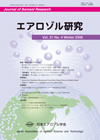巻号一覧

3 巻 (1988)
- 4 号 p. 262-
- 3 号 p. 168-
- 2 号 p. 92-
- 1 号 p. 6-
3 巻, 1 号
Spring
選択された号の論文の6件中1~6を表示しています
- |<
- <
- 1
- >
- >|
特集「粒子生成」
-
奥山 喜久夫, 吉沢 昭宣1988 年 3 巻 1 号 p. 6-22
発行日: 1988/03/20
公開日: 2011/06/23
ジャーナル フリーPDF形式でダウンロード (1504K) -
笠原 三紀夫1988 年 3 巻 1 号 p. 23-28
発行日: 1988/03/20
公開日: 2011/06/23
ジャーナル フリーPDF形式でダウンロード (644K) -
クックビル フィクレット, 小宮山 宏1988 年 3 巻 1 号 p. 29-35
発行日: 1988/03/20
公開日: 2011/06/23
ジャーナル フリーPDF形式でダウンロード (577K)
研究論文
-
岩坂 泰信, 大和 政彦, 今須 良一, 小野 晃1988 年 3 巻 1 号 p. 36-41
発行日: 1988/03/20
公開日: 2011/06/23
ジャーナル フリーDepolarization ratio of scattered light from aerosol particles strongly reflects nonsphericity of particle shape. We observed the depolarization ratio at a scattering angle = 90° for NaCl, Na2SO4 and (NH4)2SO4 particles, and the ratios from these particles were in good agreement with the measurements by Perry et al. (1978). The depolarization ratio is considered to be useful to know external mixing ratio of aerosol particles in the atmosphere.抄録全体を表示PDF形式でダウンロード (1217K) -
大田 啓一1988 年 3 巻 1 号 p. 42-48
発行日: 1988/03/20
公開日: 2011/06/23
ジャーナル フリーIn the course of a study to reveal a diurnal variation in organic components of aerosols, size-separated aerosol samples were collected during the daytime (10 : 30 — 17 : 10) and nighttime (20 : 30 — 6 : 30) in summer. The samples were analyzed for aliphatic hydrocarbons and fatty alcohols. Most aliphatic hydrocarbons in both the day and night samples were anthropogenic in origin. Contributions of diesel and gasoline engine exhausts were obvious in the day and night samples, respectively. Fatty alcohols had a natural origin. Epicuticular waxes of plants and soil were the major source materials for the >C22-alcohols. Source materials for the >C20-alcohols could not be identified. There was a difference in the relative contribution of these materials between day and night. A great difference was also observed in the atmospheric concentrations of aliphatic hydrocarbons and fatty alcohols between the day and night samples. The day sample showed high concentrations of these compounds in large particle size ranges. In the small particle size range (<0.8 μm), the night sample was above the day sample in the concentrations of the >C22-alcohols and natural source-derived hydrocarbons. Some factors governing these variations were discussed.抄録全体を表示PDF形式でダウンロード (1096K) -
H. Y. Wen, G. Kasper1988 年 3 巻 1 号 p. 49-59
発行日: 1988/03/20
公開日: 2011/06/23
ジャーナル フリーMethods of particle analysis and questions of data interpretation are discussed for cylinder gases with high initial pressure levels. It is shown that commercial pressure regulators tend to be relatively strong sources and sinks for particles. However, critical orifices are found to be useful for particle sampling from high pressure sources without altering the characteristics of the source by impaction losses or by resuspension of particles. Particle concentrations in cylinders are shown to follow exponential decay laws governed mainly by sedimentation. Particle levels are extremely sensitive to cylinder handling history. Changes from 10/ft3 to 105/ft3 (approx. 10-4/cm3 to 10/cm3) are observed in conventional uncleaned cylinders filled with N2, resulting from movement or mechanical shock of the cylinder body.抄録全体を表示PDF形式でダウンロード (1541K)
- |<
- <
- 1
- >
- >|